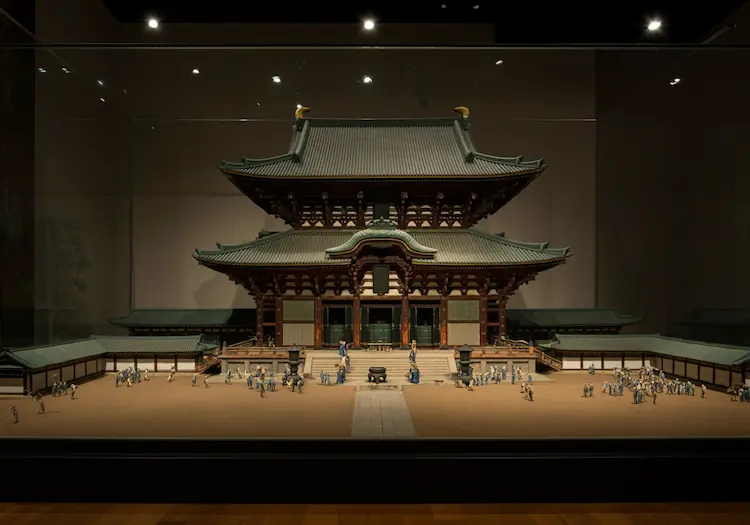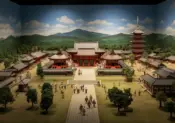Nara in the Edo Period – Serenity and Flourishing Culture
The Edo period (1603-1868) was marked by the stable rule of the Tokugawa Shogunate, bringing Japan an era of peace and prosperity. Nara, with its ancient temples and deep cultural heritage, was no exception to this flourishing period. The city saw cultural revival, religious restoration, and increased interactions with pilgrims and merchants. This article delves into the life of Nara during the Edo period, exploring its social, cultural, and religious transformations.
- Tokugawa Shogunate and Nara’s Temples
- Buddhism and Cultural Revival in Nara
- Pilgrimage and Tourism in Nara
- Economy and Townspeople Culture in Nara
- Nature and Landscape Preservation in Nara
- Modern Connections to the Edo Period in Nara
- Conclusion: Peace, Prosperity, and Cultural Flourishing in Edo-Era Nara
Tokugawa Shogunate and Nara’s Temples
- Shogunate Control and the Role of Temples: The Tokugawa Shogunate exerted control over religious institutions across Japan, striving to ensure consistency and unity in beliefs. The temples of Nara, such as Tōdai-ji and Kōfuku-ji, played crucial roles in maintaining cultural influence while cooperating with the shogunate’s policies. The support from the shogunate helped these temples not only survive but also become central pillars of cultural life in the region.
- Kōfuku-ji and the Nara Magistrate: The relationship between Kōfuku-ji and the shogunate, mediated through the Nara magistrate, showcased the political influence temples continued to wield. The magistrate acted as a bridge between the ruling government and religious authorities, ensuring that the temples’ interests aligned with the broader policies of Edo Japan.
Buddhism and Cultural Revival in Nara

- Restoration of the Great Buddha Hall: One of the most significant events of the Edo period was the restoration of the Great Buddha Hall at Tōdai-ji in 1692. This ambitious reconstruction, undertaken with the support of both local artisans and shogunate funds, revitalized the cultural and spiritual heart of Nara. The completion of this project was a symbol of resilience and renewal, attracting pilgrims and cementing Nara’s status as a center of Buddhist worship.
- Cultural Activities Flourish: During the Edo period, cultural activities such as tea ceremony, flower arranging, and calligraphy flourished in Nara. The temples served as cultural hubs, contributing not only to religious life but also to the enrichment of local culture. These activities fostered a sense of community and allowed the people of Nara to connect with their heritage in new and meaningful ways.
Pilgrimage and Tourism in Nara
- Nara as a Pilgrimage Destination: The relative peace of the Edo period allowed for the rise of pilgrimage culture. Nara became a prominent pilgrimage destination, attracting travelers to its famous temples such as Tōdai-ji, Kōfuku-ji, and Kasuga Taisha. These pilgrimages were not only spiritual journeys but also significant economic drivers, as the influx of pilgrims boosted local businesses, including inns, tea houses, and souvenir shops.
- Nara Guidebooks and Cultural Dissemination: The popularity of Nara as a pilgrimage site led to the creation of guidebooks and illustrated maps, known as “Nara-ezu,” which depicted the city’s temples, scenic spots, and routes. These guides helped spread the cultural appeal of Nara far and wide, drawing more visitors and reinforcing the city’s identity as a cultural and spiritual hub.
Economy and Townspeople Culture in Nara

- Development of Markets and Merchant Culture: The Edo period brought an increase in economic activity to Nara. Pilgrims and tourists provided a steady stream of customers, leading to the growth of markets and a vibrant merchant culture. Nara-machi, the bustling merchant quarter, became known for its tea houses and various shops selling traditional crafts and souvenirs, contributing significantly to the city’s prosperity.
- Flourishing Townspeople Culture: The townspeople of Nara played a vital role in shaping the city’s culture during the Edo period. Merchants not only drove economic growth but also supported the temples and the arts. Their contributions helped create a thriving cultural scene, characterized by festivals, artistic performances, and other communal activities that enriched daily life in Nara.
Nature and Landscape Preservation in Nara

- Protection of Kasuga Mountain and Sacred Forest: The sacred forest of Kasuga Mountain, associated with Kasuga Taisha, was preserved throughout the Edo period. The Tokugawa Shogunate and local communities both played a role in protecting this natural sanctuary, emphasizing the importance of harmony between humanity and nature. The lush greenery of Kasuga Mountain became a symbol of spiritual purity and continuity, deeply respected by the people of Nara.
- Seasonal Beauty of Nara: The scenic beauty of Nara, especially during the cherry blossoms in spring and the vibrant autumn leaves, drew many visitors during the Edo period. The seasonal changes were celebrated in art and poetry, further establishing Nara as a place where the natural landscape and cultural life were deeply intertwined.
Modern Connections to the Edo Period in Nara
- Edo-Era Heritage Sites in Modern Nara: Today, visitors to Nara can still experience the legacy of the Edo period. Many structures from this era, including temples, townhouses, and traditional shops, remain preserved in areas like Nara-machi. These historical buildings offer a glimpse into the past, allowing visitors to walk through streets that retain the charm of Edo-period Japan.
- Festivals and Historical Reenactments: Modern Nara continues to celebrate its Edo-era heritage through various festivals and events. Historical reenactments, such as those held in Nara-machi, bring to life the customs and festivities of the Edo period, offering residents and visitors alike an opportunity to connect with the history and culture that shaped the city.
Conclusion: Peace, Prosperity, and Cultural Flourishing in Edo-Era Nara
The Edo period brought Nara an era of peace, allowing it to flourish culturally and economically. The support of the Tokugawa Shogunate, the dedication of artisans and monks, and the vitality of townspeople all contributed to Nara’s growth. Pilgrimage, cultural activities, and the preservation of natural beauty helped solidify Nara’s identity as a center of tradition and spirituality. Today, the influence of the Edo period can still be felt in Nara, inviting visitors to explore the serene beauty and rich history of this timeless city.









